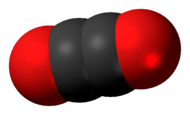Ethylene dione
 | |
| Names | |
|---|---|
| IUPAC name
Ethene-1,2-dione | |
| Systematic IUPAC name
Ethenedione | |
| Other names
Dicarbon dioxide Dimeric carbon monoxide | |
| Identifiers | |
3D model (JSmol) |
|
| ChemSpider | |
PubChem CID |
|
| |
| |
| Properties | |
| C2O2 | |
| Molar mass | 56.02 g·mol−1 |
Except where otherwise noted, data are given for materials in their standard state (at 25 °C [77 °F], 100 kPa). | |
| Infobox references | |
Ethylene dione or ethylenedione, also called dicarbon dioxide, ethenedione, or ethene-1,2-dione, is the name given to a chemical compound with the formula C2O2 or OCCO. It is the carbon-carbon covalent dimer of carbon monoxide[1] and belongs to the oxocarbon series. Because it is a dimer, it shares an empirical formula with CO. It can be thought of as ketene of glyoxylic acid (OHCCOOH).
The existence of OCCO was first suggested in 1913.[2] However, despite its deceptively "simple" structure, for over a century the compound had eluded all attempts to synthesize and observe it. Such elusive nature had earned OCCO the reputation of a hypothetical compound and a mysterious, "exceedingly coy molecule".[3]
It was not until 2015 that a group of chemists from the University of Arizona in Tucson (United States) reported the first spectroscopic characterization of OCCO, confirming its existence as a transient molecule.[4] The Arizona group created OCCO using laser light to eject electrons from the corresponding stable singly-charged anions.[5][6] Recently, spectra of oxyallyl diradical, C₃H₄O, were also found to have features nearly identical to those reported for OCCO and the spectra for ethylenedione reported by the Arizona group is reassigned to the oxyallyldiradical. [7] In conclusion, the long-lived states of ethylenedione, sought experimentally for over a century, remain unobserved. Recently, the in situ preparation and characterization of the OCCO through low-energy free-electron induced single molecular engineering has also been theoretically proposed by scientists from Bhabha Atomic Research Centre (India). [1]
Despite the existence of the closed-shell Kekulé structure, O=C=C=O, the lowest bound state of ethyledione is a triplet. Therefore, bound OCCO is formally a diradical, with an electronic structure motif similar to the oxygen molecule. However, when the molecule is distorted away from its equilibrium geometry, the potential surfaces of the triplet and singlet states intersect, allowing for intersystem crossing to the singlet state, which is unbound and dissociates to two ground-state CO molecules. The timescale of the intersystem crossing was predicted to be 0.5 ns,[8] making triplet OCCO a transient, yet spectroscopically long-lived molecule.
On the other hand, the monoanion of ethylenedione, OCCO−, as well as the divalent anion C
2O2−
2, called acetylenediolate, are both stable.[9][10]
Koch's glyoxylide
In the 1940s, Detroit physician William Frederick Koch claimed that he had synthesized this compound, which he called glyoxylide, and that it was an antidote to the toxins that caused a long list of ailments, including diabetes and cancer. The claims were false and the drug was classified as a fraud by the FDA.[11]
See also
- Cyclohexanehexone C6O6, also called triquinoyl, formally a trimer of ethylene dione.
References
- 1 2 "Communication: Low-energy free-electron driven molecular engineering: In situ preparation of intrinsically short-lived carbon-carbon covalent dimer of CO". The Journal of Chemical Physics. 146 (8): 081101. 2017-02-22. doi:10.1063/1.4976969. ISSN 0021-9606.
- ↑ H. Staudinger, E. Anthes, Ber. Dtsch. Chem. Ges. 1913, 46, 1426.
- ↑ Lewars, Errol (2008), "9 – Ethenedione C2O2", Modeling Marvels, Springer
- ↑ A. R. Dixon, T. Xue and A. Sanov, "Spectroscopy of Ethylenedione", Angew. Chem. Int. Ed., 54, 8764-8767 (2015), doi:10.1002/anie.201503423.
- ↑ "UA Researchers Reveal Elusive Molecule". UA News. 13 July 2015. Retrieved 14 July 2015.
- ↑ "An elusive molecule—finally revealed". Phys.Org. 13 July 2015. Retrieved 14 July 2015.
- ↑ Lunny, K. G., Benitez, Y., Albeck, Y., Strasser, D., Stanton, J. F. and Continetti, R. (), Spectroscopy of Ethylenedione and Ethynediolide: A Reinvestigation. Angew. Chem.. Accepted Author Manuscript. doi:10.1002/ange.201801848
- ↑ D. Schröder, C. Heinemann, H. Schwarz, J. N. Harvey, S. Dua, S. J. Blanksby, and John, H. Bowie, "Ethylenedione: An Intrinsically Short-Lived Molecule", Chem. Eur. J., 4, 2550-2557 (1998).
- ↑ J. R. Thomas, B. J. DeLeeuw, P. O’Leary, H. F. Schaefer III, B. J. Duke, B. O’Leary "The ethylenedione anion: Elucidation of the intricate potential energy hypersurface", J. Chem. Phys, 102, 6525-6536(1995).
- ↑ P. Pyykkö and N. Runeberg, "Ab initio studies of bonding trends: Part 8. The 26-electron A≡B-C≡Dn and the 30-electron A=B=C=Dn systems", J. Mol. Struct. THEOCHEM, 234, 269-277(1991).
- ↑ William W. Goodrich interview for FDA Oral History Program, Part 2. Rockville, Maryland, 15 October 1986.